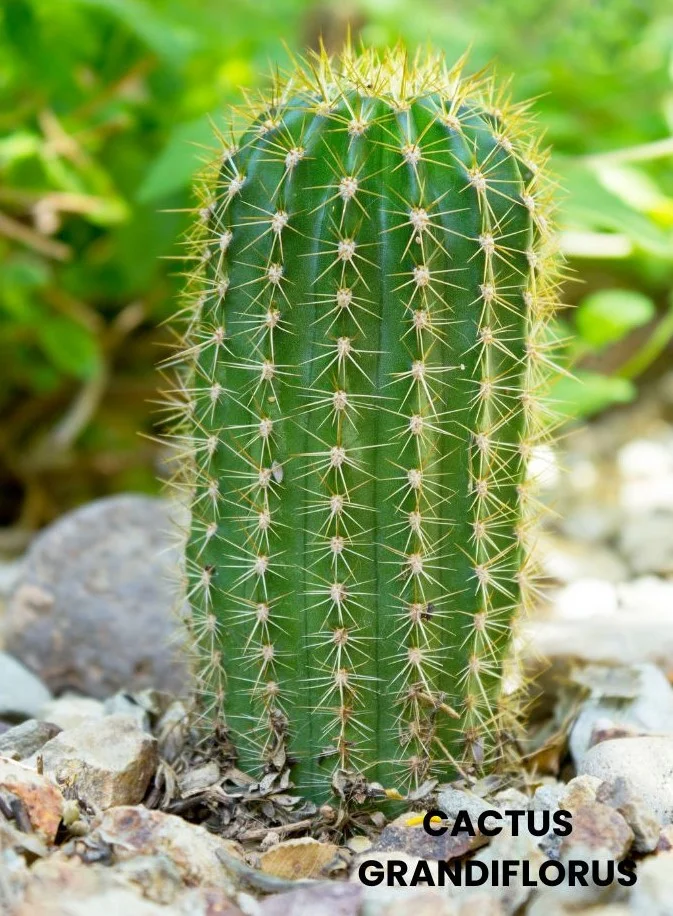Cactus grandiflorus, also known as Selenicereus spinulosus or Night-blooming Cereus, is a homeopathic remedy derived from a species of cactus.
It is primarily used to address heart-related conditions and symptoms such as palpitations, chest constriction, and angina pectoris.

Table of Contents
ToggleSOURCE INFORMATION
Scientific Classification
- Kingdom: Plantae
- Clade: Tracheophytes
- Clade: Angiosperms
- Clade: Eudicots
- Order: Caryophyllales
- Family: Cactaceae
- Genus: Selenicereus
- Species: Selenicereus spinulosus (synonym: Cactus grandiflorus)
Origin and Distribution
- Cactus grandiflorus is native to regions of Central and South America, where it grows in dry, desert-like conditions.
- It is also cultivated in other parts of the world for ornamental purposes due to its striking nocturnal flowers.
Historical Facts
- Cactus grandiflorus has a rich history of use in traditional medicine among indigenous communities of Central and South America.
- Its medicinal properties, particularly its effects on the heart and circulatory system, have been recognized for centuries.
Homoeopathic Preparation
- In homeopathy, Cactus grandiflorus is prepared from the flowers of the plant and diluted to various potencies for therapeutic use.
- The potentized remedy is believed to retain the energetic properties of the original plant material.
DRUG PATHOGENESIS
- Cactus grandiflorus acts primarily on the circular muscular fibres, leading to characteristic constrictions felt throughout the body.
- It affects the heart and arteries, producing sensations as if being bound by an iron band.
- Mental symptoms often mirror those associated with heart conditions, such as sadness and melancholy.
KEY CHARACTERISTICS
- Heart and Arteries: Characteristic constrictions resembling an iron band, affecting the heart and arteries.
- Mental Symptoms: Melancholy, sadness, fear of death, and anxiety.
- Periodicity: Symptoms often exhibit great periodicity, recurring at specific times of the day.
- Haemorrhage: Tendency towards haemorrhage with formation of clots.
DETAILED ORGAN SYMPTOMS
PSYCHOLOGICAL PROFILE
- Melancholy: A state of persistent sadness or low mood.
- Sadness: Feelings of sorrow or unhappiness, often accompanied by a sense of gloom.
- Fear of death: An intense fear or apprehension related to the idea of dying or mortality.
- Anxiety: Feelings of worry, nervousness, or unease, often about an imminent event or uncertain outcome.
HEAD
- Headache: Individuals may experience headaches, often accompanied by a sensation of weight on the vertex.
- Congestive headaches: Headaches characterized by a feeling of congestion or fullness in the head.
- Pulsating pain: Pulsating or throbbing pain, particularly felt on the right side of the head.
FEVER
- Fever occurs daily at the same hour, indicating a regular pattern.
- Sensation of coldness in the back and icy-cold hands accompany the fever.
- The fever is intermittent, with paroxysms around midday, specifically at 11 a.m.
- Paroxysms are incomplete in their stages and are often accompanied by hemorrhages.
- Coldness is predominant during the fever episode, accompanied by cold sweat and significant anguish.
- Despite the fever episodes, there is a persistent subnormal temperature.
CHEST
Chest Constriction and Breathing Difficulty
- Sensation of chest constriction as if bound, hindering normal breathing.
- Inflammation of the diaphragm, causing discomfort and difficulty in breathing.
Heart Constriction and Palpitations
- Feeling of heart constriction, as if bound by an iron band.
- Symptoms of angina pectoris, characterized by chest discomfort, suffocation, and cold sweat.
- Palpitations, with a sensation of the heart pounding, often worsening when lying on the left side or nearing menstruation.
- Shooting pain down the left arm, often associated with heart conditions.
- Experience of violent palpitations, accompanied by vertigo, difficulty breathing, and flatulence.
Haemoptysis and Cough
- Haemoptysis, or coughing up blood, often occurring with convulsive, spasmodic coughing.
Diaphragmatic Inflammation
- Diaphragmitis, leading to significant difficulty in breathing, exacerbated by inflammation of the diaphragm.
Endocarditis and Cardiac Incompetence
- Presence of endocarditis with mitral insufficiency, leading to violent and rapid heart action.
- Effectiveness in the early stages of cardiac incompetence.
- Heart weakness associated with arteriosclerosis and conditions like tobacco heart.
- Sensation of constriction and acute pains in the heart region, with a feeble, irregular pulse lacking strength.
- Presence of endocardial murmurs, excessive impulse, increased dullness in the precordial area, and enlargement of the ventricle.
- Low blood pressure, a characteristic feature in cases requiring treatment with Cactus grandiflorus.
FEMALE SYMPTOMS
- Constriction in Uterine Region and Ovaries: Sensation of tightness or constriction in the uterine region and ovaries.
- Dysmenorrhea: Experience of pulsating pain in the uterus and ovaries during menstruation.
- Vaginismus: Involuntary contraction of the vaginal muscles, causing discomfort or pain, especially during intercourse.
- Menstrual Irregularities: Menstrual periods may occur early and have a dark, pitch-like appearance.
- Cessation of Menstruation on Lying Down: Menstruation may cease when lying down, accompanied by symptoms related to heart conditions.
MODALITIES
Aggravation
- About noon: Symptoms worsen around midday.
- Lying on the left side: Symptoms aggravate when lying on the left side of the body.
- Walking: Symptoms worsen during physical activity such as walking.
- Going upstairs: Symptoms worsen when ascending stairs or inclines.
- 11 a.m. and 11 p.m.: Symptoms exacerbate at these specific times.
Amelioration
- Open air: Symptoms improve in fresh, outdoor air.
WHAT ARE MODALITIES IN HOMOEOPATHY?
RELATIONSHIP WITH OTHER DRUGS
- Antidoted by Aconite, Camphor, and Cinchona.
- Shares similarities with Digitalis, Spigelia, Convallaria, Kalmia, Naja, and Magnolia.
DOSE
- Tincture or dilutions up to the third attenuation are commonly used.
- Higher potencies are indicated for nervous palpitations.
Meaning of Difficult Words
- Angina Pectoris: Chest pain or discomfort caused by reduced blood flow to the heart muscle.
- Dysmenorrhea: Painful menstruation.
- Haemorrhage: Excessive bleeding, particularly from a ruptured blood vessel.
- Haemoptysis: Coughing up blood from the respiratory tract.
- Palpitations: Awareness of one’s heartbeat, often characterized by a rapid, irregular, or pounding heart rate.
- Tincture: A concentrated herbal extract obtained by soaking plant material in alcohol.
